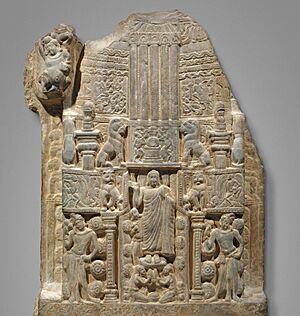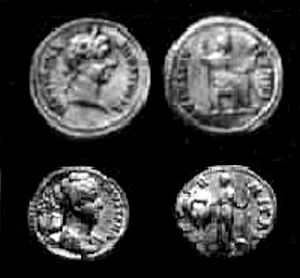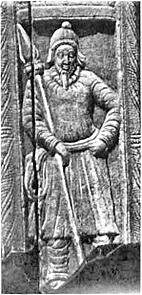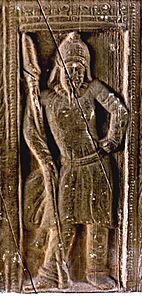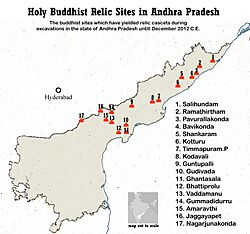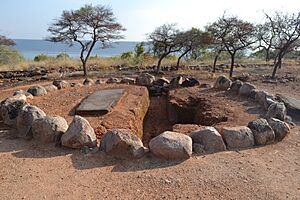Nagarjunakonda facts for kids
Quick facts for kids Nagarjuna Konda |
|
|---|---|
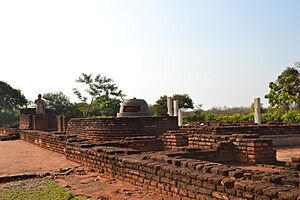
Ruins of the site
|
|
| Location | Macherla mandal, Palnadu district, Andhra Pradesh, India |
| Governing body | Archaeological Survey of India |
| Lua error in Module:Location_map at line 420: attempt to index field 'wikibase' (a nil value). | |
Nagarjunakonda (which means Nagarjuna Hill) is a very old town that is now an island. It's located near Nagarjuna Sagar in the Palnadu district of Andhra Pradesh, India. This place is one of India's most important Buddhist sites. Today, most of it lies under a big lake, which was formed by the Nagarjuna Sagar Dam. When the dam was built, the old buildings and artifacts at Nagarjunakonda were going to be covered by water. So, archaeologists carefully dug them up and moved them to higher ground. This higher ground is now an island.
Long ago, this site was a huge Buddhist university. Students came from far away places like China, Gandhara, Bengal, and Sri Lanka to study here. You can still find ruins of many Mahayana Buddhist and Hindu temples. The amazing sculptures found at Nagarjunakonda are now in museums around the world. They are famous for their unique "Amaravati style." There was also a palace area with rare carvings that show influences from ancient Rome.
The modern name, Nagarjunakonda, comes from Nagarjuna. He was an important Buddhist teacher who lived in the 2nd century. People once thought he helped build this site, but that's probably not true. The original name of the town, when it was most active, was "Vijayapuri." This Nagarjunakonda in Andhra Pradesh is different from the Nagarjuna caves near the Barabar Caves in Bihar.
Contents
A Look Back in Time: History of Nagarjunakonda
Old coins found at Nagarjunakonda show that kings from the Satavahana family lived here a long time ago. An old writing also proves that Buddhism was present in this area by the 2nd century AD.
The Ikshvaku Kings and a Golden Age
Nagarjunakonda became very important around 225 AD. This happened after the Satavahana kings lost their power. The Ikshvaku king, Vashishthiputra Chamamula, made this place his capital city, calling it Vijayapuri. We know about four Ikshvaku kings from coins and writings found here.
The Ikshvaku kings built many temples for Hindu gods like Shiva and Kartikeya. Their queens and other important women also built many Buddhist monuments. It's believed that over 30 Buddhist monasteries were here during this time. Archaeologists have found many artworks and writings that help us understand this early period.
The Ikshvaku rule ended around 309 AD. After that, the site became less important. Later, between the 7th and 12th centuries, some brick temples were built when the Chalukyas ruled. The area then became part of the Kakatiya and Delhi Sultanate kingdoms. Nagarjunakonda became important again in the 15th and 16th centuries. At that time, it was a hill fort, likely built by the Reddi rulers to protect their main fort. Later, the Gajapati kings controlled it. In 1515, the Vijayanagara king Krishnadevaraya captured the fort.
Uncovering the Past: Archaeological Discoveries
In 1926, a local teacher named Suraparaju Venkataramaih found an old pillar. He told the government about it. Soon, experts realized this was an important historical site.
The first discoveries were made in 1926 by a French archaeologist, Gabriel Jouveau-Dubreuil. Then, English archaeologists led by A. H. Longhurst dug here from 1927 to 1931. They found ruins of many Buddhist stupas (dome-shaped structures) and chaityas (prayer halls), along with other monuments and sculptures.
More digging happened in 1938. Then, in 1954, a big problem arose. The new Nagarjuna Sagar Dam was being built, and the whole site was going to be flooded! So, a huge effort began, led by R Subrahmanyam, to save the historical treasures. From 1954 to 1960, archaeologists worked quickly. They found many relics from the Stone Age all the way to the 16th century.
Later, about 14 large copies of the excavated ruins and a museum were built on the Nagarjunakonda hill. Some of the original sculptures are now in museums in Delhi, Chennai, Kolkata, Paris, and New York.
In 1960, the dam was finished, and the original site was covered by the reservoir's water. But thanks to dedicated archaeologists, almost all the important relics were saved. Many monuments were carefully moved to the top of Nagarjuna's Hill, where a museum was built in 1966. Other monuments were moved to the mainland.
What Was Found: Buddhist Ruins
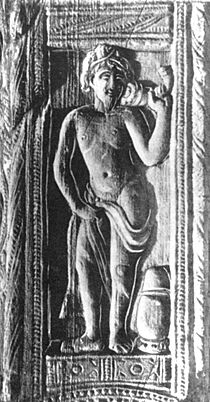
Writings found at the site show that the Ikshvaku kings and their families supported Buddhism. The Ikshvaku queens, especially Camtisiri, even funded the building of the main stupa for ten years! Many non-royal people also supported the Buddhist buildings. At its peak, Nagarjunakonda had over thirty monasteries. It was the biggest Buddhist center in South India.
Writings also show that Buddhist scholars from places like Sri Lanka, Tamil kingdoms, Orissa, Gandhara, and China came here. There's even a footprint at one monastery that people believe is a copy of Gautama Buddha's footprint.
The great stupa at Nagarjunakonda was a large brick structure, plastered and decorated. It was about 32 meters wide and 18 meters tall. The carvings found here are very similar to those from the Amaravati Stupa nearby.
What Was Found: Hindu Ruins
Most of the Hindu ruins found at Nagarjunakonda are related to the god Shiva. One temple has a writing that names the god as "Mahadeva Pushpabhadraswami," which is another name for Shiva. Stone statues of Kartikeya (also called Murugan) were found at two other temples. At least one temple, from 278 AD, was for the god Vishnu, based on a statue of an eight-armed god. A large sculpture of the goddess Devi was also discovered.
Greco-Roman and Scythian Finds
Archaeologists found some interesting items that show connections with ancient Greece and Rome. Roman gold coins, called aurei, were discovered. One was from the time of Emperor Tiberius (16-37 AD) and another from Empress Faustina the Elder (141 AD). These coins suggest that people here traded with the Roman world. A carving of Dionysus, a Greek god, was also found at the Nagarjunakonda Palace site.
You can also see carvings of Scythian soldiers. These soldiers wore special caps and coats. An old writing suggests that the Ikshvaku kings might have had a group of Scythian guards stationed here.
Ancient Writings: Inscriptions
The Nagarjunakonda inscriptions are a collection of ancient writings found in the area. They tell us a lot about the Buddhist buildings and the rule of the Ikshvaku kings, from about 210 to 325 AD.
These writings often highlight how many different kinds of Buddhist monks came to Nagarjunakonda. One writing describes monks from places like Kashmir, Gandhara, and Sri Lanka living in a monastery. This shows that many different people were involved with Buddhism here.
The writings are in ancient languages like Prakrit and Sanskrit, or a mix of both. They are all written in the Brahmi script. The Nagarjunakonda inscriptions are some of the earliest important Sanskrit writings found in South India. They talk about both Buddhism and the Hindu Shiva tradition.
The use of Sanskrit writings in the south might have come from the Western Satraps, who were kings who liked to use Sanskrit. They had close ties with rulers in South India. One writing says that the Ikshvaku king Virapurushadatta (250-275 AD) had many wives. One of them was the daughter of the ruler of Ujjain, who might have been a Western Satrap king.
What's in a Name?
The modern name, Nagarjunakonda, comes from the Buddhist scholar Nagarjuna. "Konda" means "hill" in the Telugu language. However, the things found here don't actually prove that Nagarjuna was connected to the site. The old writings from the 3rd and 4th centuries clearly show that the place was called "Vijayapuri" back then. The name "Nagarjunakonda" came much later, in medieval times. The Ikshvaku writings always linked their capital Vijayapuri with the Sriparvata hill.
An ancient Chinese traveler named Fa-Hien visited this area. In his travel diary, he mentioned a five-story monastery on top of the hill, dedicated to Kassapa Buddha. He said each story looked like a different animal, with the top one shaped like a pigeon. Fa-Hien called the monastery Po-lo-yue, which some think means Pārāvata (pigeon) or Parvata (hill).
Another Chinese traveler, Hiuen-Tsang, visited around 640 AD. He called the place Po-lo-mo-lo-ki-li, which means "Mountain of the Black Bee." This was because it was known as Bhramaragiri, and had a shrine to the goddess Bhramaramba. However, some experts believe he was talking about a different place in Odisha.
The Nagarjunasagar Dam and Island Museum
The Nagarjunasagar Dam is the tallest stone dam in the world. It was built between 1955 and 1967. The old Buddhist remains that were dug up were carefully rebuilt and placed in a museum. This museum is on an island in the middle of the man-made Nagarjunasagar Lake.
The island has a 14th-century fort, medieval temples, and a museum that looks like a Buddhist monastery. The museum has many Buddhist artifacts and art. These include a small tooth and an earring believed to belong to Gautama Buddha. The main stupa of Nagarjunakonda, called Mahachaitya, is thought to hold sacred items of the Buddha. A partly ruined stone statue of the Buddha is a main attraction at the museum. It also has historical finds like tools from the Stone Age, as well as carvings, coins, and jewelry.
Visiting Nagarjunakonda
Nagarjunakonda Island is in the Guntur district and you can't reach it directly by road. The closest train station is at Macherla, about 29 kilometers away. You mostly get to the island by taking a ferry from the mainland.
The area around the dam also offers beautiful views of the valley. You can also visit the Ethipothala Falls, a natural waterfall that drops 22 meters into a blue lagoon. This lagoon is also a place where crocodiles breed. The nearby Srisailam wildlife sanctuary and the Nagarjunsagar-Srisailam Tiger Reserve are home to many different reptiles, birds, and animals. Srisailam, located on the Krishna River, is a very important historical and religious site. It has a Shiva temple that is one of the 12 sacred Jyotirlingas in India.
Images for kids


